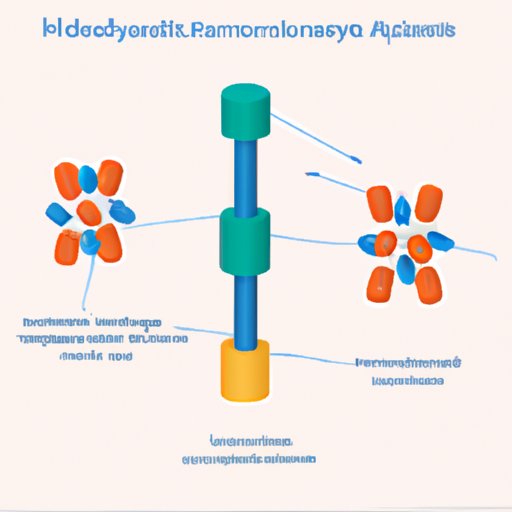Introduction
A monoclonal antibody (mAb) is an artificially generated antibody that can be used to identify and target specific molecules or cells. While the body naturally produces antibodies to fight infection and illness, mAbs are produced in laboratories using recombinant DNA technology.
The use of mAbs has revolutionized medical research, diagnosis, and treatments for a variety of illnesses and diseases. In this article, we’ll explore the science behind mAbs, their structure and function, production, uses and benefits, and their role in disease treatment and diagnostics.
Exploring the Science Behind Monoclonal Antibodies
In order to understand how mAbs work, it’s important to have a basic understanding of what they are and how they are made. Let’s start by exploring the definition of mAbs.
Definition of Monoclonal Antibodies
An mAb is a type of protein produced in a laboratory by fusing two types of cells: a B cell and a myeloma cell. The B cell is an immune system cell that recognizes and binds to a specific antigen, while the myeloma cell helps to produce large quantities of the mAb protein.
The Structure and Function of Monoclonal Antibodies
The structure of mAbs is similar to that of natural antibodies, but they have a few distinct differences. For example, mAbs are composed of four polypeptide chains: two heavy chains and two light chains. These chains are connected together through disulfide bonds, which give the mAb its unique shape and stability.
The function of mAbs is to recognize and bind to a specific antigen. Each mAb is designed to recognize one particular antigen, making them very specific and highly effective at targeting the molecule or cell associated with that antigen.
How Monoclonal Antibodies are Produced
The production of mAbs involves a complex process of cloning, culturing, and purifying the cells to create the desired protein. First, a B cell that has been exposed to a specific antigen is isolated and fused with a myeloma cell. This fusion creates a “hybridoma” cell, which is then cloned to create a large population of identical cells. These cells are then cultured in a nutrient medium and allowed to grow and divide, producing large quantities of the desired mAb.
The mAbs are then purified and tested for quality control before being used in research or clinical applications.
Monoclonal Antibody Basics: How Does It Work?
Now that we’ve explored the science behind mAbs, let’s take a look at how they work and what they are used for.
What Are Monoclonal Antibodies Used For?
mAbs are used for a wide range of applications, including medical research, diagnostics, and disease treatment. They can also be used as therapeutic agents to treat certain illnesses and diseases.
How Monoclonal Antibodies Work
When a mAb is introduced into the body, it binds to the target antigen, forming a complex. This complex is then recognized by the immune system, triggering an immune response. Depending on the type of mAb, this response can either stimulate or suppress the immune system.
Examples of Monoclonal Antibodies in Use
mAbs are used in many different areas of medicine. For example, they are used to diagnose cancer, test for infectious diseases, and monitor organ transplant rejection. They are also used in the treatment of autoimmune diseases, such as rheumatoid arthritis and Crohn’s disease.

A Comprehensive Guide to Understanding Monoclonal Antibodies
Now that we’ve discussed the basics of mAbs, let’s explore some of the more detailed aspects of these proteins.
Different Types of Monoclonal Antibodies
There are several different types of mAbs, each with its own unique properties. For example, there are mAbs that are designed to bind to specific antigens, mAbs that are used to block or inhibit the activity of a target molecule, and mAbs that are used to deliver drugs or other therapeutic agents to specific cells or tissues.
Uses of Monoclonal Antibodies
mAbs are used in a variety of medical applications, from diagnostics to disease treatment. They can also be used to study the structure and function of proteins, to detect and quantify molecules, and to develop new drugs.
Benefits of Monoclonal Antibodies
The use of mAbs offers several advantages over traditional methods of diagnosis and treatment. They are highly specific, meaning they can be used to target and bind to very small molecules or cells. They are also easy to produce in large quantities, allowing them to be used in clinical trials and research studies.

The Role of Monoclonal Antibodies in Disease Treatment
mAbs are increasingly being used in the treatment of various diseases and illnesses. Let’s take a look at how they are used and the potential side effects of mAb therapy.
How Monoclonal Antibodies are Used in Disease Treatment
mAbs can be used to target and destroy diseased cells, such as cancer cells, or to inhibit the activity of certain molecules involved in the disease process. They can also be used to deliver drugs or other therapeutic agents directly to the affected area.
Potential Side Effects of Monoclonal Antibody Therapy
Although mAbs are generally safe, they can cause side effects in some individuals. These side effects can include allergic reactions, inflammation, and other adverse reactions. As with any medical treatment, it’s important to discuss the potential risks and benefits with your doctor before beginning mAb therapy.

How Monoclonal Antibodies Can Be Used in Diagnostics
mAbs can also be used in diagnostic tests to detect and quantify molecules or cells. Let’s take a look at how mAbs are used in diagnostics and the advantages and disadvantages of mAb-based tests.
Diagnostic Tests Using Monoclonal Antibodies
mAbs are often used in diagnostic tests to detect the presence of a specific molecule or cell. They can also be used to quantify the amount of a specific molecule or cell present in a sample. Examples of mAb-based diagnostic tests include ELISA (enzyme-linked immunosorbent assay) and Western blotting.
Advantages and Disadvantages of Monoclonal Antibody-Based Tests
The use of mAbs in diagnostic tests offers several advantages over traditional methods. mAb-based tests are more sensitive and specific than other tests, meaning they can detect even small amounts of the target molecule or cell. They are also faster and easier to perform than other tests.
However, mAb-based tests also have some drawbacks. For example, they are expensive to produce and can only be used to detect a single molecule or cell type at a time.
Conclusion
In conclusion, mAbs are a powerful tool for medical research, diagnostics, and disease treatment. They offer several advantages over traditional methods, including greater specificity, speed, and ease of use. However, it’s important to be aware of the potential risks and side effects of mAb therapy before beginning treatment.
Summary
This article provided an in-depth overview of monoclonal antibodies, including their structure and function, production, uses and benefits, and role in disease treatment and diagnostics. We also discussed the different types of mAbs, their uses in diagnostics, and the potential side effects of mAb therapy.
Final Thoughts
The use of mAbs has revolutionized medical research and treatment for a variety of illnesses and diseases. With further research, mAbs may continue to play an important role in improving human health.
(Note: Is this article not meeting your expectations? Do you have knowledge or insights to share? Unlock new opportunities and expand your reach by joining our authors team. Click Registration to join us and share your expertise with our readers.)
